

|
Back to |
| The Front Page |
| News & Features |

|
Branding the sport in print advertising |
|
by James Hawkins Posted October 15, 2013
|
James Hawkins has authored one of the most recent books on "serious croquet" and has successfully established a club with new and refurbished facilities in his native Liverpool. As former editor of the English Croquet Gazette and a frequent contributor to Croquet World Online Magazine, he enjoys exploring the broader cultural context of the sport, yielding insights into the formation and perpetuation of a public image club players can hardly recognize. Most of all those ads show toy equipment in relaxed family settings, so it's not surprising that croquet is popularly known as a casual game and not a serious sport. In fact, most clubs in most countries can now give novices a choice of games: the fun and social game of Golf Croquet to start; and the more intense sport of Association Croquet, which could take a lifetime to explore and perfect. Hawkins invites novices to play either or both in Liverpool. Stroll through our Digital Gallery to get a better view and to read the wording.
Technology is great. Whenever I want to engage in the retail experience (or "do some shopping" as we used to say), Facebook will pop up an ad based on my previous browsing history. All I do is prod my shiny telephone screen with a finger a couple of times, walk to the front door, and there's a cardboard box full of my merchandise. Simple and quick, and, save for a couple of grunts between me and the FedEx delivery man, free of all that unpleasant human interaction which used to ruin attempts to purchase stuff.
Back in the unsophisticated 20th century, people used to visit shops to buy things, and they used to rely on someone to tell them what those things were. Modern advertisers know that (a) I spent yesterday looking online for my nearest optician, and (b) that I've spent ages on price comparison sites looking for a new lawnmower. I don't even need to leave my armchair for see a sidebar of spectacle frames, specially selected to be relevant to me. It's kind of efficient, and I'm more or less sold on the idea of getting my eye test from the company that's on my screen right now.
Half a century - or even five years - ago, advertising was much less about the hi-tech targeted delivery mechanism, and more about the creative message. Using specific images as a shorthand for a brand's values was key, and a few companies used croquet to sell their product.
Ironically, the easiest way to investigate this is to go shopping on the Internet. In an online community of 200 million buyers and sellers, eBay has made millionaires of some of its sellers, and paupers out of buyers. Smart people have dusted down the stacks of yellowing copies of Time Magazine from the attic, scalpelled out the ads, and flogged them at $3.99 plus postage. Just take a look: search for "croquet ad" on eBay right now, and you'll see maybe 50 or so examples.
That's remarkable. Even in the 1940s, 50s and 60s, when organised croquet was at its lowest ebb, advertisers could rely on enough instant recognition of the game to promote their products. Those ads are now online for the collector to buy and cherish. It's a roster of brands including some mainstream producers - Seven Up, Band Aid, Budweiser and Chrysler.
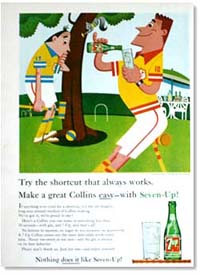
[better view] |
Maybe the use of croquet in advertisers' imagery isn't as prevalent as I make it appear. Here's a highly unscientific test: search for "croquet ad" on eBay (50 results); search for "tennis ad" (800 results). Croquet - as it does in the real world - occupies a tiny niche, and the scarcity of the imagery reflects that. But the subtext of that imagery may give some insights into how the world sees our sport.
Mid-20th century Britain saw an era of massive social change. The country was bankrupt, the Empire was crumbling, and the class structure was collapsing. Croquet had been a game for the pre-war (and pre-Depression) middle classes, and it was the last thing the newly empowered proletariat would aspire to. UK adverts from this period are thin on the ground, but here's an example from 1937.
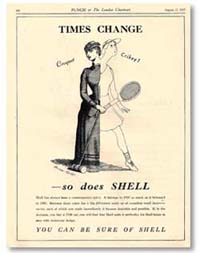
[better view] |
While the Brits were washing their hands of tradition, and aspiring to such newfangled modernity as gasoline and tennis, American admen were feeding consumers with the opposite message. The mid 20th century was a time for nest-building, and advertisers were quick to feed what would become the postwar baby boom.
Blue collar workers were no longer heading down to their local bar after a shift at the factory. Beer now came in bottles for home consumption. "In this friendly, freedom-loving land of ours, beer belongs ... enjoy it" claimed the ads. Neighbours share a beer and a chat over the fence, and the family entertain themselves with a barbeque and a croquet match.
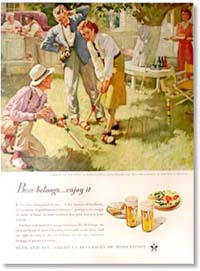
[better view] |
(By the way, the artwork for this advertisement is credited to the legendary graphic artist Haddon Sundblom. Sundblom's lasting legacy was the creation of the portrayal of Santa Claus with rosy cheeks, a long white beard and a red and white coat. The colour scheme was conceived for Coca Cola's Christmas campaign, and the imagery has since seeped out of the confines of the advert and into our collective consciousness.)
Croquet depicted as part of the domestic idyll surfaces in surprising examples. This ad from 1955 for the South Carolina State Development Board shows Mom, Dad and their young daughter cheerfully stoking the family barbeque while enjoying a game of croquet. Relocate your factory here, runs the argument, and you'll find happy and stable workers who are more loyal and productive.

[better view] |
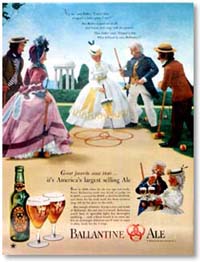
[better view] |
"No no," said Father, "I won't play;
Croquet's a lady's game, I say!"
But Mother argued not at all,
Just traced three rings with her parasol.
Then Father cried, "Croquet is fine,
When followed by some Ballantine!"
That was the message for products which wanted to emphasise that theme. But others were keener to stress the opposite. "Live Modern, Smoke Modern, with L&M cigarettes" says this one. Happy golfers enjoy the "modern miracle" of L&M's filter tips, while musty old croquet players pose stiffly in their Victorian garb. "Free yourself of old-fashioned ideas... enjoy the richer flavor of modern living."
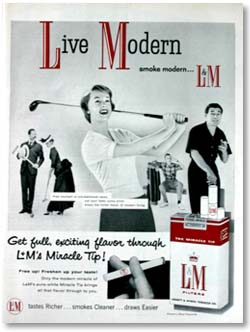
[better view] |
By the 1960s, croquet's popularity seems to have waned, and advertisers had lost some interest in portraying it. Fewer and fewer examples exist, but here's an alarming example from 1968 for feminine hygiene products. The accompanying copy (and I'll spare you a transcription) pulls no punches in its assessment of the bad old days of long skirts and croquet:

[better view] |
A generation had now passed since the peak of croquet advertising. The social associations of the game had started to faded from the consciousness of consumers. By the 1990s, croquet had become a hook on which to hang the creativity of the graphic designer. Here's Bombay Dry Gin:
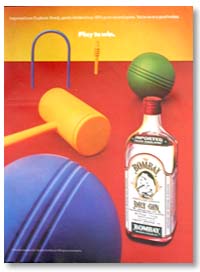
[better view] |
and an absurdly pretentious game of croquet in this double page spread for Louis Vuitton. By the time of this recent British advert, the class struggle has resolved itself (or, to be more accurate, the haves and have-nots have started to become irrelevant to each other). Now, in the designer label-led 21st century, croquet is a chromium-plated accessory for your $2,000 wristwatch.
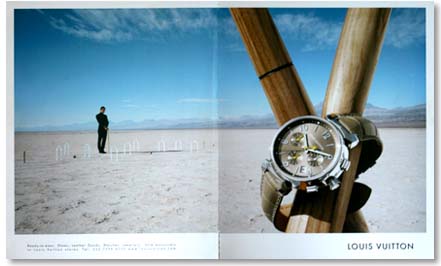
[better view] |
Given time and enough obsessive compulsiveness, anyone could amass quite a collection of croquet artwork. I've been a prolific eBay buyer over the last ten years, and I now have about 150 examples. That's about the top limit of what you'll ever find online. I've taught myself the valuable skill of picture framing, and some of the finer prizes line the walls at home. Up and down my stairs I can trace the waves from social aspiration of the 1940s, to anti-aspiration of the 60s, and back to aspiration again.
Mass-market print advertising may be a dwindling artform, but it gives us some insight into attitudes to our sport. It's unlikely that the new media marketing of today will give us a similar snapshot in 50 years' time.